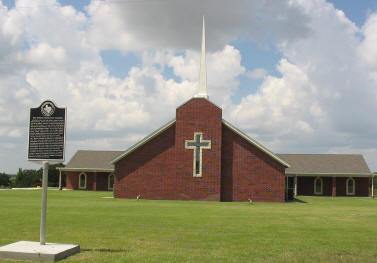May, Texas, Brown County, Recorded Texas Historic Landmark. (original) (raw)

May Cemeter with windmill
Photo courtesy historictexas.net, 9-03
More Texas Cemeteries
History in a Pecan Shell
Named for settler W. D. May, the town was started with a store opened by May�s brother Nathan in 1879 and a post office was granted in 1881.
The town was a stop on the Brownwood North and South Railway from 1907 until the line was given up in 1927.
In 1940 May had 500 residents, but it began a slow decline over the decades to the current 285.
Historical Marker: US 183, at May Community Center, May
The May Community
Originally part of a Mexican land grant given to empresario John Cameron in 1827, May developed in the 1870s when several pioneer families settled here. Baptists and Methodists quickly organized churches. A one-room school known as Old Swayback provided the first formal education for the children. Nathan L. May built a trading post in 1879 and became the town's first postmaster in 1881. By 1907 the village had a blacksmith shop, general store, newspaper and bank. The early history of May climaxed in 1911 with the coming of the railroad.
(1981)

May United Methodist Church
Photo courtesy historictexas.net, 9-03
Historical Marker: 18001 US 183 N
May United Methodist Church
Methodists in this area were initially served by circuit-riding preachers. First to come to the region in the 1860s was the Rev. Hugh M. Childress, and worship services were held in private homes. In 1882, the Rev. Peter Gravis organized Mt. Zion Methodist Church, which later merged with the congregation at Byrds. Both of these communities, along with Bethel, Brooks, Clio, Gap Creek, Green's Chapel, Holder, Pleasant Valley, Rocky, Shrum, Verbena, Williams, Windham and Wolf Valley became part of the May charge. Brush arbor revivals were held each summer.
The May Methodist Church was formally organized in 1886. Members gathered for services in nearby Verbena until 1890, when they began meeting in the newly constructed May schoolhouse. Four years later, members built their own one-room church, which served until they constructed a new brick building with memorial stained glass windows in 1929-30. After 70 years of service, the church building was destroyed by fire in January 2000.
Throughout its history, the May United Methodist Church has upheld the ideals and traditions of its pioneer founders. Despite the Depression, droughts, floods, wars and fire, the church has served its members and the May community for more than 100 years.
(2001)

May United Methodist Church historical marker
Photo courtesy historictexas.net, 9-03
More Texas Churches
Historical Marker: May, 6 miles W on CR 411
Lost Creek Cemetery
The original Hog Creek Cemetery was established in the 1870s, about one-half mile southwest of this site; after only two burials, the community chose to relocate, reportedly because of the rocky soil there. J. W. Graves (d. 1874) was the first person buried at this location, then owned by H.C. Hancock. Area residents continued to use the site and, in 1892, J.C. Hensley (Henslee) and his wife, L.E., deeded it to Brown County for cemetery and church purposes. A chapel was constructed by 1932, and the Hog Creek Cemetery Association organized in 1949, later changing its name, and that of the cemetery, to Lost Creek.
Historic Texas Cemetery - 2002
Texas Escapes, in its purpose to preserve historic, endangered and vanishing Texas, asks that anyone wishing to share their local history, stories, landmarks and recent or vintage photos, please contact us.